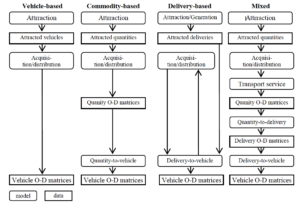A paper by Daniel Kaszubowski of Gdansk University of Technology provides a review of urban freight transport demand modelling approaches confronted with constrains regarding adequate data availability from a perspective of the local authorities.
Demand estimation models have been selected as a reference because they are the most representative in terms of inclusion of urban freight indicators which can be transformed into a decision-support tool for evaluation of freight measures.
Urban freight models
The main categories of urban freight models related to their function include:
- Demand estimation models. Their main objective is to estimate the demand for freight in an urban area or its part and to relate this demand to socio-economic and spatial characteristics of chosen area.
- Fixed-demand optimisation models, which are related to optimisation research. Their function is not to estimate the demand to be distributed but to optimise the transportation process. These models derive from the well-known families of location-routing and vehicle routing problems. The demand is known or estimated with other categories of models.
- Multi-actor simulation models, which main function is to simulate the behavior of the involved stakeholders instead of estimation the demand.
- Macro-economic and public decision support models. They evaluate action and solutions for urban goods distribution and in the most cases are dependent on the other categories of proposed models.
The demand models are fundamental for an ex-ante assessment of policies and measures that can be implemented by local administration in order to make urban freight system more sustainable and reduce the total cost of transport system operations. The basis for simulation is to estimate freight origin-destination (O-D) flows. This can be achieved by taking as the reference unit either quantity moved or delivery (commodity-based or delivery based) or freight vehicles by which transport is made (truck-based). Also a mixed commodity/delivery-based approach can be considered.
Local authorities
The main concern is to find a balance between an effort required to create a reliable urban freight analysis framework and transport policy’s objectives. Delivery-based models has been considered as the most promising in terms of possible results and ability to represent different aspects of urban supply chains in a coherent way. As they use a vehicle movement as a descriptor, the results can be presented in measurable way in terms of general transport planning framework.
Local authorities facing problems with monitoring urban freight activities needs scalable support tools reflecting as much aspects of this issue as possible at acceptable cost and time of response. Despite relatively high level of complication the delivery-based models have a potential to meet this challenge. They are based on common indicator for both the receiver and the shipper which is the delivery. Data about deliveries can be obtained at an acceptable cost using somehow complicated, but still manageable direct establishment surveys complemented with on-street observations and vehicle drivers’ questionnaires about trip pattern (origin and number of stops in round).
A movement of vehicle (delivery or pick-up) used as main indicator may also be considered through the road occupancy as a trip and parking time, what assures the measurability of objective and possibility to compare it with existing traffic counts. When properly calibrated, the surveys’ results may be transferred to other city’s areas to estimate their demand for deliveries (vehicle movements) without repeating the survey. This approach gives only estimated results, but still this at acceptable level of detail for general evaluation.

